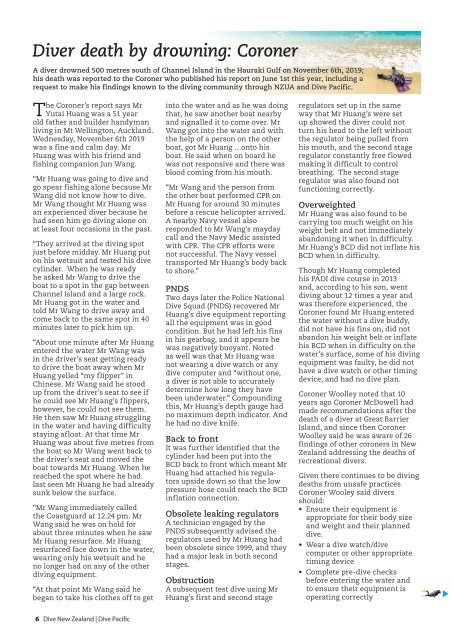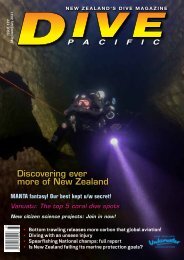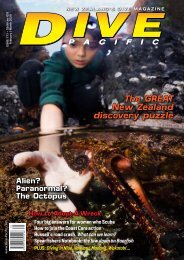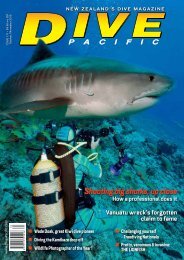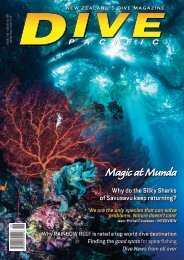DIVE PACIFIC 178 Sept-Nov 2021
Featuring Whale Shark at the door! (?), the threats from WWII wrecks in the Pacific, climate change impacts on kelp forests and coral reefs, new columns, superb u/w/photos and more
Featuring Whale Shark at the door! (?), the threats from WWII wrecks in the Pacific, climate change impacts on kelp forests and coral reefs, new columns, superb u/w/photos and more
Create successful ePaper yourself
Turn your PDF publications into a flip-book with our unique Google optimized e-Paper software.
Diver death by drowning: Coroner<br />
A diver drowned 500 metres south of Channel Island in the Hauraki Gulf on <strong>Nov</strong>ember 6th, 2019;<br />
his death was reported to the Coroner who published his report on June 1st this year, including a<br />
request to make his findings known to the diving community through NZUA and Dive Pacific.<br />
The Coroner’s report says Mr<br />
Yutai Huang was a 51 year<br />
old father and builder handyman<br />
living in Mt Wellington, Auckland.<br />
Wednesday, <strong>Nov</strong>ember 6th 2019<br />
was a fine and calm day. Mr<br />
Huang was with his friend and<br />
fishing companion Jun Wang.<br />
“Mr Huang was going to dive and<br />
go spear fishing alone because Mr<br />
Wang did not know how to dive.<br />
Mr Wang thought Mr Huang was<br />
an experienced diver because he<br />
had seen him go diving alone on<br />
at least four occasions in the past.<br />
“They arrived at the diving spot<br />
just before midday. Mr Huang put<br />
on his wetsuit and tested his dive<br />
cylinder. When he was ready<br />
he asked Mr Wang to drive the<br />
boat to a spot in the gap between<br />
Channel Island and a large rock.<br />
Mr Huang got in the water and<br />
told Mr Wang to drive away and<br />
come back to the same spot in 40<br />
minutes later to pick him up.<br />
“About one minute after Mr Huang<br />
entered the water Mr Wang was<br />
in the driver’s seat getting ready<br />
to drive the boat away when Mr<br />
Huang yelled “my flipper” in<br />
Chinese. Mr Wang said he stood<br />
up from the driver’s seat to see if<br />
he could see Mr Huang’s flippers,<br />
however, he could not see them.<br />
He then saw Mr Huang struggling<br />
in the water and having difficulty<br />
staying afloat. At that time Mr<br />
Huang was about five metres from<br />
the boat so Mr Wang went back to<br />
the driver’s seat and moved the<br />
boat towards Mr Huang. When he<br />
reached the spot where he had<br />
last seen Mr Huang he had already<br />
sunk below the surface.<br />
“Mr Wang immediately called<br />
the Coastguard at 12.24 pm. Mr<br />
Wang said he was on hold for<br />
about three minutes when he saw<br />
Mr Huang resurface. Mr Huang<br />
resurfaced face down in the water,<br />
wearing only his wetsuit and he<br />
no longer had on any of the other<br />
diving equipment.<br />
“At that point Mr Wang said he<br />
began to take his clothes off to get<br />
into the water and as he was doing<br />
that, he saw another boat nearby<br />
and signalled it to come over. Mr<br />
Wang got into the water and with<br />
the help of a person on the other<br />
boat, got Mr Huang …onto his<br />
boat. He said when on board he<br />
was not responsive and there was<br />
blood coming from his mouth.<br />
“Mr Wang and the person from<br />
the other boat performed CPR on<br />
Mr Huang for around 30 minutes<br />
before a rescue helicopter arrived.<br />
A nearby Navy vessel also<br />
responded to Mr Wang’s mayday<br />
call and the Navy Medic assisted<br />
with CPR. The CPR efforts were<br />
not successful. The Navy vessel<br />
transported Mr Huang’s body back<br />
to shore.”<br />
PNDS<br />
Two days later the Police National<br />
Dive Squad (PNDS) recovered Mr<br />
Huang’s dive equipment reporting<br />
all the equipment was in good<br />
condition. But he had left his fins<br />
in his gearbag, and it appears he<br />
was negatively buoyant. Noted<br />
as well was that Mr Huang was<br />
not wearing a dive watch or any<br />
dive computer and “without one,<br />
a diver is not able to accurately<br />
determine how long they have<br />
been underwater.” Compounding<br />
this, Mr Huang’s depth gauge had<br />
no maximum depth indicator. And<br />
he had no dive knife.<br />
Back to front<br />
It was further identified that the<br />
cylinder had been put into the<br />
BCD back to front which meant Mr<br />
Huang had attached his regulators<br />
upside down so that the low<br />
pressure hose could reach the BCD<br />
inflation connection.<br />
Obsolete leaking regulators<br />
A technician engaged by the<br />
PNDS subsequently advised the<br />
regulators used by Mr Huang had<br />
been obsolete since 1999, and they<br />
had a major leak in both second<br />
stages.<br />
Obstruction<br />
A subsequent test dive using Mr<br />
Huang’s first and second stage<br />
regulators set up in the same<br />
way that Mr Huang’s were set<br />
up showed the diver could not<br />
turn his head to the left without<br />
the regulator being pulled from<br />
his mouth, and the second stage<br />
regulator constantly free flowed<br />
making it difficult to control<br />
breathing. The second stage<br />
regulator was also found not<br />
functioning correctly.<br />
Overweighted<br />
Mr Huang was also found to be<br />
carrying too much weight on his<br />
weight belt and not immediately<br />
abandoning it when in difficulty.<br />
Mr Huang’s BCD did not inflate his<br />
BCD when in difficulty.<br />
Though Mr Huang completed<br />
his PADI dive course in 2013<br />
and, according to his son, went<br />
diving about 12 times a year and<br />
was therefore experienced, the<br />
Coroner found Mr Huang entered<br />
the water without a dive buddy,<br />
did not have his fins on, did not<br />
abandon his weight belt or inflate<br />
his BCD when in difficulty on the<br />
water’s surface, some of his diving<br />
equipment was faulty, he did not<br />
have a dive watch or other timing<br />
device, and had no dive plan.<br />
Coroner Woolley noted that 10<br />
years ago Coroner McDowell had<br />
made recommendations after the<br />
death of a diver at Great Barrier<br />
Island, and since then Coroner<br />
Woolley said he was aware of 26<br />
findings of other coroners in New<br />
Zealand addressing the deaths of<br />
recreational divers.<br />
Given there continues to be diving<br />
deaths from unsafe practices<br />
Coroner Wooley said divers<br />
should:<br />
• Ensure their equipment is<br />
appropriate for their body size<br />
and weight and their planned<br />
dive.<br />
• Wear a dive watch/dive<br />
computer or other appropriate<br />
timing device<br />
• Complete pre-dive checks<br />
before entering the water and<br />
to ensure their equipment is<br />
operating correctly<br />
6 Dive New Zealand | Dive Pacific


